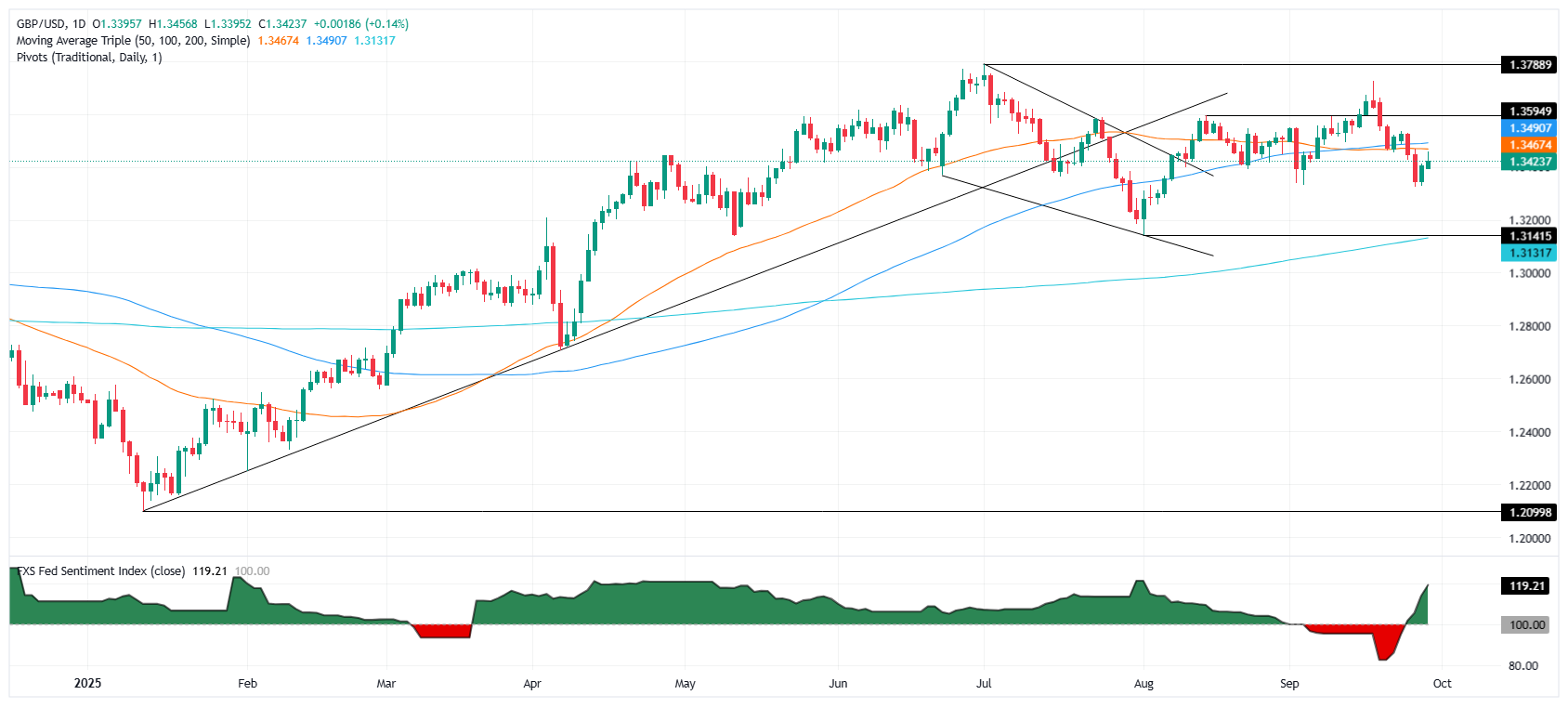GBP/USD rises as Fed rate cut bets grow, US shutdown risks loom
- Sterling gains as Fed seen delivering two cuts, while BoE expected to hold rates steady despite stalled disinflation.
- BoE’s Ramsden confident restrictive policy will tame inflation, while Cleveland Fed’s Hammack warns inflation remains stubbornly high.
- US shutdown risks mount as BLS signals data blackout, overshadowing upbeat pending home sales and upcoming Fed speakers.
The GBP/USD advances on Monday as the Greenback trims some of the last week’s gains as a busy economic docket in the US approaches. The pair trades at 1.3430, up 0.24%.
GBP/USD rises despite UK fiscal concerns, boosted by central bank divergence and political focus at Labor conference
Fears of a potential government shutdown in the US, weighs on the Dollar despite remaining concerns of UK finances. On Monday, the Labor Party conference began in Liverpool this week, and it would be the focus for investors, revealed Chris Turner head of forex strategy at ING.
Aside from this, the central bank divergence favors further GBP/USD upside. The Bank of England is expected to hold rates unchanged at the next meeting, while market participants priced in almost two rate cuts by the Federal Reserve.
BoE Deputy Governor Dave Ramsden was hawkish, as he said the UK’s disinflationary trend stalled. He said that he remains “confident we will get inflation back to target with current restrictive rates and market expectations.”
Across the pond, Cleveland Fed Beth Hammack reiterated her hawkish stance, saying that inflation is too high and the trend is in the wrong direction. She added that tariffs are a big part of the pause of the disinflation process.
Second tier data in the US revealed that Pending Home Sales improved in August rose by 4% MoM, up from an upward revised -0.3% contraction in July and above forecasts of a 0.3% expansion.
Meanwhile, breaking news revealed that the US Bureau of Labor Statistics reportedly plans not to release economic data during Government shutdown, according to Bloomberg. The BLS to suspend all operations in case of Government shutdown.
Up next, the US economic docket will feature further Fed speakers, with Regional Fed Presidents Alberto Musalem, John Williams and Raphael Bostic, crossing the wires.
GBP/USD Price Forecast: To consolidate, unless spot prices fall below 1.34
The technical picture shows back-to-back bullish days, but the GBP/USD remains shy of reversing the drop from around the 1.3480-1.3500 area, which would keep Sterling with a downward bias momentum.
The Relative Strength Index (RSI) shows that sellers are in charge. If GBP/USD remains below 1.3466, the September 25, expect further downside with the next area of interest being the 1,3400 figure. A breach of the latter will expose September 25 swing low of 1.3323.

Pound Sterling Price This Month
The table below shows the percentage change of British Pound (GBP) against listed major currencies this month. British Pound was the strongest against the New Zealand Dollar.
| USD | EUR | GBP | JPY | CAD | AUD | NZD | CHF | |
|---|---|---|---|---|---|---|---|---|
| USD | -0.30% | 0.47% | 1.05% | 1.26% | -0.51% | 1.78% | -0.33% | |
| EUR | 0.30% | 0.77% | 1.29% | 1.56% | -0.21% | 2.08% | -0.03% | |
| GBP | -0.47% | -0.77% | 0.40% | 0.79% | -0.97% | 1.31% | -0.75% | |
| JPY | -1.05% | -1.29% | -0.40% | 0.29% | -1.52% | 0.76% | -1.33% | |
| CAD | -1.26% | -1.56% | -0.79% | -0.29% | -1.74% | 0.51% | -1.52% | |
| AUD | 0.51% | 0.21% | 0.97% | 1.52% | 1.74% | 2.30% | 0.22% | |
| NZD | -1.78% | -2.08% | -1.31% | -0.76% | -0.51% | -2.30% | -2.03% | |
| CHF | 0.33% | 0.03% | 0.75% | 1.33% | 1.52% | -0.22% | 2.03% |
The heat map shows percentage changes of major currencies against each other. The base currency is picked from the left column, while the quote currency is picked from the top row. For example, if you pick the British Pound from the left column and move along the horizontal line to the US Dollar, the percentage change displayed in the box will represent GBP (base)/USD (quote).

